Lynn station
Lynn station (signed as Central Square–Lynn) is an intermodal transit station in downtown Lynn, Massachusetts. It is a station on the MBTA Commuter Rail Newburyport/Rockport Line and a hub for the MBTA bus system. The station consists of a single center island platform serving the two station tracks on an elevated grade. A large parking garage is integrated into the station structure.
Central Square – Lynn | |||||||||||
|---|---|---|---|---|---|---|---|---|---|---|---|
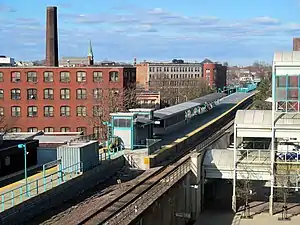 Lynn station viewed from the parking garage in 2015 | |||||||||||
| Location | 325 Broad Street, Lynn, Massachusetts | ||||||||||
| Coordinates | 42°27′46″N 70°56′45″W | ||||||||||
| Line(s) | Eastern Route | ||||||||||
| Platforms | 1 island platform | ||||||||||
| Tracks | 2 | ||||||||||
| Connections | |||||||||||
| Construction | |||||||||||
| Parking | 965 spaces | ||||||||||
| Bicycle facilities | 14 spaces | ||||||||||
| Disabled access | Yes | ||||||||||
| Other information | |||||||||||
| Fare zone | 1A (until end of 2020) | ||||||||||
| History | |||||||||||
| Opened | 1838 (first depot) | ||||||||||
| Rebuilt | 1848, 1872, 1895, 1952, January 21, 1992[1] | ||||||||||
| Previous names | Central Square | ||||||||||
| Passengers | |||||||||||
| 2018 | 549 (weekday average boardings)[2] | ||||||||||
| Services | |||||||||||
| |||||||||||
Service on the Eastern Railroad through Lynn began on August 27, 1838. The original wooden station was replaced by a larger structure in 1848, and the Saugus Branch began serving Lynn in 1855. In the "Great Lynn Depot War", a local disagreement in 1865 about where to place a replacement station became a major court case. It ended in 1872 with the construction of stations at two closely spaced sites, though one was soon torn down. The other station burned in 1889; it was replaced in 1895 by a depot with a large clock tower.
The Boston and Maine Railroad (B&M), which had acquired the Eastern in 1883, began a grade separation project through Lynn in 1909 – part of an attempt to quadruple-track the whole line. Completed in 1914, it expanded the station to four tracks and two island platforms, with the 1895-built structure modified "not for the better". It was replaced in 1952 by a modernist brick structure. Saugus Branch service ended in 1958; service on the mainline was subsidized beginning in 1965 by the Massachusetts Bay Transportation Authority (MBTA).
The MBTA opened a new accessible island platform in 1992, along with a large parking garage that anticipated a never-realized extension of the Blue Line. Lynn is also a major bus transfer point serving eleven MBTA bus routes in the North Shore region, including routes leading to Salem, Marblehead, Wonderland, and the Liberty Tree Mall as well as downtown Boston. In 2003, the bus routes were moved to a busway adjacent to the garage.
History
Early history
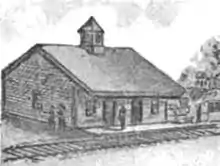
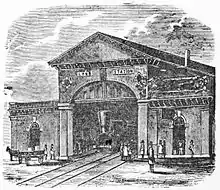
After the railroads from Boston to Lowell, Worcester, and Providence were chartered in 1830 and 1831, railroads to other surrounding cities including Newburyport and Portsmouth were proposed. The Eastern Railroad was chartered on April 14, 1836.[3][4] Work began at East Boston in late 1836; it reached Lynn in the spring of 1837, but construction was slowed by the Panic of 1837 and did not reach Salem until 1838.[5] Service from Salem to East Boston began on August 27, 1838, with fares half that of competing stagecoaches.[3][5]
The line through Lynn was built at surface level.[4] A number of stations have served Lynn, including a series of stations near the current location at Central Square as well as a number of other stations around the city.[6] The first depot at the Central Square location, built in 1838, was a small wooden building.[6]
The station was the site of an early protest against the discrimination of African-Americans in transportation. On September 29, 1841, noted abolitionist Frederick Douglass and friend James N. Buffum (later mayor of Lynn) were thrown from an Eastern Railroad train when Douglass refused to sit in the segregated train coach.[7] Trains were ordered to not stop at Lynn for several days out of concern that the citizens of Lynn would cause additional incidents.[5]:28
On June 16, 1846, the stockholders authorized the sale of $450,000 of new stock to fund various branch lines plus new depots at Salem and Lynn.[5] The 1838-built station was replaced in 1848 by a brick building with a 2-track train shed, modeled after the 1847-built station at Salem but smaller and lacking towers.[5]
In 1845 and 1846, a line from Malden to Salem via Saugus and Lynnfield was proposed but did not pass the legislature due to bitter objections from the Eastern. Instead, the Saugus Branch Railroad opened from Malden to Lynn Common on February 1, 1853. Affiliated with the Eastern's primary rival, the Boston and Maine Railroad (B&M), it did not initially have a connection with the Eastern.[5] In 1855, the Eastern acquired the majority stock of the Saugus Branch Railroad to keep it away from the B&M. The connection to the B&M at Malden was severed, and it was connected to the Eastern at South Malden (Everett) and West Lynn.[5] Lynn became the primary turnback point for the Saugus Branch after 1855, though a limited number of trains continued to Salem until World War I.[4]
The first horsecars ran to Lynn in 1854 under the Lynn and Boston Railroad.[8] Its line ran between its namesake cities; running through Charlestown on Chelsea Street, Chelsea and Revere on Broadway, then along the Salem Turnpike to Lynn.[9] On November 19, 1888, the Highland Circuit route of the Lynn & Boston became the first electrified trolley line in Massachusetts.[10][11]
Great Lynn Depot War
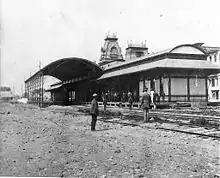
When the Eastern Railroad prepared to build a new depot in 1865, a great deal of controversy erupted – an event later known as the "Great Lynn Depot War". One faction wanted the replacement station built at the same Central Square location, while another wanted it built at Knight's Crossing, a block southwest at Market Street.[12] The Central Square faction was aided by a bill passed in the Massachusetts legislature on April 29, 1865, which disallowed a railroad from abandoning a station that had been in service more than five years, as well as an 1868 bill that specifically directed the Eastern Railroad to build the replacement station at Central Square.[13]
After a case which reached the Supreme Court in 1871 and a subsequent appeal to the United States Court, a decision was ultimately made to construct stations at both locations.[13] Both the Central Square and Market Street stations were in service by mid-1872, but it was untenable for the railroad to serve two stations just several hundred feet apart. The Market Street station was demolished in 1873 and replaced with a wooden shelter that served only a handful of trains.[13]
The depot controversy was a setback for the Eastern Railroad in a city where residents were already dissatisfied with poor service. In 1872, the Boston, Revere Beach and Lynn Railroad (BRB&L) was charted as a direct competitor to the Eastern; service began from Market Street in 1875 and lasted until 1940.[5][14] Service to East Boston had been replaced with direct service to Boston via the Grand Junction Railroad in 1854, but Lynn–East Boston service was run from 1872 to 1880 to compete with the BRB&L. In 1880, the service was cut to a Revere–East Boston shuttle,which lasted until 1905.[4]
From approximately the 1850s to the 1930s, Lynn was the terminus for some short turn Boston commuter trains. From 1881 to 1892, some of these trains ran via the Chelsea Beach Branch during the summer.[4]
Track elevation
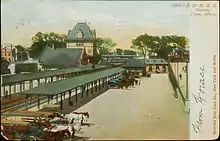
The 1872 Central Square station burned in 1889 and was replaced with a temporary station until a new depot with a 75-foot clock tower was built in 1895 on the north side of the tracks off Union Street. This station had two side platforms to serve the line's two tracks. As early as 1901, the city began planning to eliminate the numerous grade crossings in downtown Lynn. With 150 trains per day on the main line and 40 on the Saugus Branch, some streets were blocked for as long as half of daylight hours.[15] After legal issues, construction of an elevated viaduct began in September 1909. However, the New Haven Railroad briefly gained control of the Boston and Maine at this time, and intended to fully four-track the line through Lynn in conjunction with plans including a possible railroad tunnel under the harbor. The municipality initially intended to force the railroad to depress the four-track line below grade, but later reached an agreement with the railroad to modify the two-track viaduct for four tracks.[15]
The New Haven's plan to four-track the line as far as the branch line splits in Salem and Beverly was stymied by the costs to modify the grade crossings in Chelsea and the single-track tunnel at Salem. The only quadruple track to become operational was at Lynn station itself, with two island platforms to serve trains on all tracks.[15] The depot was modified "not for the better" in conjunction with the elevation project.[6] Many of the four-track bridge spans in Lynn, never used operationally, are still extant.[4]
B&M era
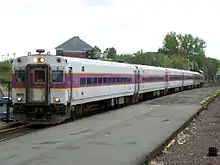
Streetcars service to Lynn continued under the Lynn & Boston until 1901 when it became part of the Boston and Northern Street Railway.[8] By the early 20th century, a number of lines crisscrossed Lynn, with a number of them serving the station.[16] The Bay State Street Railway took over operations in 1911 and joined the Eastern Massachusetts Street Railway in 1919. Trolley service in Lynn lasted until 1938.[8]
The Boston and Maine Railroad built a new, more modern station in 1952 but reused the 1914-built platforms. This single-story building, located on the south side of the tracks at Mt. Vernon and Exchange streets, was in the same flat-roofed brick style as Winchester Center and Wedgemere built five years later. The building was the first on the Boston & Maine system to have radiant heat, and also included a restaurant and newsstand. The 1895-built station was demolished to make room for a parking lot.[6] Saugus Branch service ended in May 1958, leaving through service on the Eastern Route as the only trains serving Lynn.[4] Around this time, the third and fourth tracks through the station were removed due to reduced traffic, leaving the station with effectively two side platforms serving two tracks.[17]
MBTA era
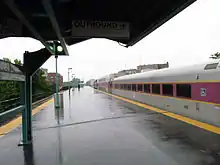
By the late 1980s, the nearly-40-year-old station and the older platforms were crumbling. Since the Newburyport/Rockport line was no longer a freight clearance route past the General Electric plant in West Lynn, a full-length high-level platform was built to replace the 1952 platforms. The wide platform occupies the width of one former island platform plus one track slot, with the line's two current tracks on each side. The 1,100-foot (340 m)-long platform is located west of the older low platforms, which are still extant on the viaduct. A 1,000-space parking garage with a drop-off lane was built off Market Street; buses continued to use the former busway on Mount Vernon Street at Central Square. Entrances to the platform are available from the garage and from Central Square. The $50 million facility opened on January 21, 1992.[1] The station was constructed with two elevators and an escalator to platform level.[18] The escalator was no longer functional by 1995; it was later walled off along with one elevator.[19] Along with the pair at Framingham, the remaining elevator is one of the few on the commuter rail system maintained by the MBTA, rather than by Amtrak or local agencies.[20]
In 2003, the MBTA spent slightly less than $100,000 to rehabilitate the deteriorated garage and to convert the drop-off lane into a full busway with shelters, benches, and signage.[21] The busway opened on September 9, 2003 and 21 MBTA bus routes were rerouted from Central Square.[1][22] In late 2005, the MBTA spent $168,000 for repairs to the garage roof, which frequently leaked during rain.[21] The 1992 station was built with new concrete ties supporting the tracks connecting to the station, which proved less durable than expected. In September 2008, the MBTA board authorized a $1 million tie replacement and slope stabilization project at the station.[23]
In 2015, the Lynn garage had the lowest utilization rate of MBTA garages, partially due to safety concerns and partially because it was built to support future Blue Line demand.[6][24] In 2011, 20 security cameras were added to the station as a reaction to several assaults in the garage.[25]
In August 2016, the MBTA began a $6.1 million improvement project at the station. The work includes drainage improvements, sidewalk and cobblestone replacement, stair and elevator repairs, painting of the garage structure to prevent rust, structural repairs to the garage, expansion joint replacement, and platform repairs. It was expected to be completed by November 2016.[26] As of June 2019, the MBTA is planning a $60+ million renovation project that will include elevator and platform replacement.[27]
Lynn and River Works stations were changed from fare Zone 2 to Zone 1A (allowing subway-fare rides to Boston) from May 22–31 and July 1–December 31, 2020 to provide additional travel options during the COVID-19 pandemic (as many of the 400-series bus routes were reduced in frequency) and to examine the impact of temporary fare changes.[28]
Future
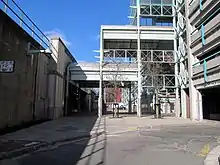
Lynn is intended to be the terminus of a future extension of the MBTA Blue Line, which would bring the line 4.5 additional miles from Wonderland in Revere to Lynn. This extension has been proposed in various forms for over 90 years. The 1926 Report on Improved Transportation Facilities and 1945–47 Coolidge Commission Report recommended that the East Boston Tunnel line, which had been converted to rapid transit from streetcars in 1924, be extended to Lynn via the Boston, Revere Beach & Lynn right-of-way.[29] Ever since the 1954 Revere extension was cut short to Wonderland, a further extension to Lynn has been planned. Following on the 1926 and 1945-47 studies, the 1966 Program for Mass Transportation recommended that the Blue Line be extended to Lynn, while the 1969 Recommended Highway and Transit Plan proposed that the extension run as far as Salem. An extension was not present in the 1972 Final Report of the Boston Transportation Planning Review, but the 1974 Transportation Plan revived the project with possible termini of Lynn, Salem, or even Route 128 in Peabody.[29] The 1978 Program for Mass Transportation report and 1983 Transportation Plan both continued support for an extension to Lynn.[29] Despite the continued recommendations, however, other projects like extensions of the Red and Orange lines were given funding instead of the Blue Line.
Despite numerous studies on the project and previous bond bills, there is currently no identified funding source; due to the MBTA's constrained finances, construction is not likely to begin soon. The 1992-built Lynn parking garage, designed for the capacity needed for the Blue Line extension, does not fill fully from commuter rail ridership.[6]
Other Lynn stations
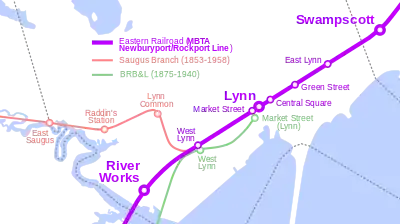
Lynn has also been home to eight other stations on different sites – none of which lasted into the MBTA era – plus a ninth that opened in 1965. Besides its downtown stops, the Eastern Railroad also served East Lynn from 1880 until Marblehead Branch service ended in June 1959. Stairways from the Chatham Street to the station site still exist, although no station building remains.[30] The 1896 depot was disassembled in 1912 in preparation for the downtown grade separation. It was moved to Durham, New Hampshire, where it now serves as the University of New Hampshire Dairy Bar and a station stop on Amtrak's Downeaster service. A West Lynn station was located at Commercial Street at the junction with the Saugus Branch Railroad, and Green Street was briefly located just east of Central Square.[31][32] Neither the West Lynn nor Green Street buildings survive.
The Boston, Revere Beach & Lynn also served its own Lynn depot (a block away from the Eastern Railroad station) at Market Street near Broad Street, as well its own West Lynn station adjacent to the Eastern Railroad station just east of Commercial Street.[32] Neither station is still extant.
Service on the Saugus Branch Railroad began from Boston to Lynn (via Malden) in 1853, serving Central Square and West Lynn plus three new stations in northwest Lynn. These included Lynn Common station at Western Avenue, Raddin's Station at Summer Street and Raddin Grove Avenue, and East Saugus at Lincoln Avenue on the Saugus/Lynn border.[32] Passenger service on the branch ended in May 1958; the branch is now abandoned and being turned into a rail trail.[31] None of the station buildings survive, though the surviving Cliftondale station in Saugus was identical to the East Saugus station.[6]
River Works station is located in West Lynn on the Newburyport/Rockport Line. Opened on September 9, 1965 as G.E. Works, it is for the sole use of GE Aviation employees.[1] Swampscott station, located just outside Lynn in Swampscott, Massachusetts, also serves passengers from East Lynn.
Bus connections
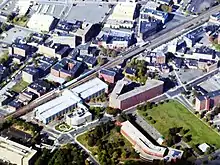
Lynn serves as a major hub and transfer point for MBTA bus routes serving the North Shore area. All routes pull into the station busway off Route 1A, though some also stop at Central Square at the station's Exchange Street entrance.
- 426: Central Square, Lynn–Haymarket station
- 426W: Central Square, Lynn–Wonderland station
- 429: Northgate Shopping Center–Central Square, Lynn
- 435: Liberty Tree Mall–Central Square, Lynn via Peabody Square
- 436: Liberty Tree Mall–Central Square, Lynn via Goodwin Circle
- 439: Nahant–Wonderland station
- 441: Marblehead–Wonderland Station via Paradise Road
- 442: Marblehead–Wonderland station via Humphrey Street
- 455: Salem Depot–Wonderland station
- 456: Salem Depot–Central Square, Lynn
References
- Belcher, Jonathan. "Changes to Transit Service in the MBTA district" (PDF). NETransit.
- Central Transportation Planning Staff (2019). "2018 Commuter Rail Counts". Massachusetts Bay Transportation Authority.
- Felt, Joseph Barlow (1845). Annals of Salem. pp. 297–298 – via Internet Archive.
- Humphrey, Thomas J. & Clark, Norton D. (1985). Boston's Commuter Rail: The First 150 Years. Boston Street Railway Association. pp. 75–77. ISBN 9780685412947.
- Bradlee, Francis Boardman Crowninshield (1917). The Eastern Railroad: A Historical Account of Early Railroading in Eastern New England. Essex Institute. p. 91 – via Internet Archive.
- Roy, John H. Jr. (2007). A Field Guide to Southern New England Railroad Depots and Freight Houses. Branch Line Press. pp. 140, 184–186. ISBN 9780942147087.
-
 The full text of Page:My Bondage and My Freedom (1855).djvu/411 at Wikisource
The full text of Page:My Bondage and My Freedom (1855).djvu/411 at Wikisource - Vandervoort, Bill. "Transit Systems in Massachusetts: Boston Area". Chicago Railfan. Retrieved 17 February 2013.
- Chase, J.G. (1865), Rail Road Map Showing the Street Rail Road Routes in and leading from Boston, with the Terminus of Each Road in Suburban Cities and Towns
- "The Thomson-Houston Road at Lynn, Mass". The Electrical World. 12 (23): 303. December 8, 1888 – via Google Books.
- "Cambridge Led Off: Days Recalled When the City Government First Granted Permission for Electric Street Cars". Cambridge Tribune. 11 February 1905. Retrieved 3 November 2014.
- Allen, Charles (1871). Annual Report of the Attorney General for the Year ending December 31, 1870. Wright and Potter. p. 12. Retrieved 20 March 2012.
- Newhall, James R. (1897). HISTORY OF LYNN, ESSEX COUNTY, MASSACHUSETTS:INCLUDING Lynnfield, Saugus, Swampscott, and Nahant. 2. The Nichols Press. pp. 40–42. Retrieved 20 March 2012.
- Bradlee, Francis Boardman Crowninshield (1921). The Boston, Revere Beach and Lynn Narrow Gauge Railroad. Essex Institute. pp. 1–5 – via Google Books.
- Breed, Charles B. (16 September 1915). "Track Elevation at Lynn, Mass.". Engineering News. Hill Publishing Co. 74 (12): 533–537.
- "Lynn 1909 Plate 01". Atlas of Lynn, Swampscott and Saugus, 1905. L.J. Richards. 1909. Retrieved 17 February 2013.
- "Historic Aerials (aerial imagery of Lynn)". NETR Online. 1971. Retrieved 20 February 2013.
- Laidler, John (January 19, 1992). "Lynn MBTA station to open". Boston Globe – via Newspapers.com.

- "N.C. center's transit study doesn't sit well with MBTA official". Boston Globe. December 7, 1998. p. 18 – via Newspapers.com.

- TranSystems and Planners Collaborative (August 24, 2007). "Evaluation of MBTA Paratransit and Accessible Fixed Route Transit Services: Final Report" (PDF). Massachusetts Bay Transportation Agency. p. 40.
- Santoro, Phil (3 November 2005). "T to repair leaky garage in Lynn". Boston Globe. Retrieved 3 April 2016.
- "Transportation and City Of Lynn Officials Applaud Opening Of New Intermodal Facility" (Press release). Massachusetts Bay Transportation Authority. 9 September 2003. Archived from the original on 25 September 2003.
- "Agenda for September 11, 2008 Board Meeting". Massachusetts Bay Transportation Authority. 11 September 2008. Retrieved 3 August 2008.
- Leighton, Paul (17 September 2015). "Half empty or half full?: Fewer cars than expected using Salem, Beverly MBTA garages". Salem News. Archived from the original on 1 October 2015.
- "Improvements to Lynn Commuter Rail Station" (Press release). Massachusetts Bay Transportation Authority. June 2, 2011.
- Grillo, Thomas (August 12, 2016). "Central Square Station Repairs Underway". Item Live. Retrieved August 15, 2016.
- Brelsford, Laura (June 5, 2019). "SWA Initiatives—June 2019" (PDF). Massachusetts Bay Transportation Authority Department of System-Wide Accessibility. p. 6.
- "Lynn Zone 1A Pilot: Fares at Lynn Commuter Rail Station Lowered to Zone 1A Extended through December 31" (Press release). Massachusetts Bay Transportation Authority. August 13, 2020.
- Central Transportation Planning Staff (15 November 1993). "The Transportation Plan for the Boston Region – Volume 2". National Transportation Library. Retrieved 3 July 2012.
- Chambers, Ted (27 September 2009). "Re-opening the East Lynn Commuter Rail Station". Lynn Happens. Retrieved 13 March 2012.
- Karr, Ronald Dale (1995). The Rail Lines of Southern New England. Branch Line Press. pp. 266–267. ISBN 0942147022.
- L.J. Richards (1905). "Lynn & Saugus & Swampscott 1905 Index Plate". Atlas of Lynn, Swampscott and Saugus, 1905. WardMaps LLC. Retrieved 26 October 2012.
External links
| Wikimedia Commons has media related to Lynn station. |
- MBTA – Lynn
- Lynn station on Google Maps Street View: Market Street entrance, Union Street entrance, Exchange Street entrance